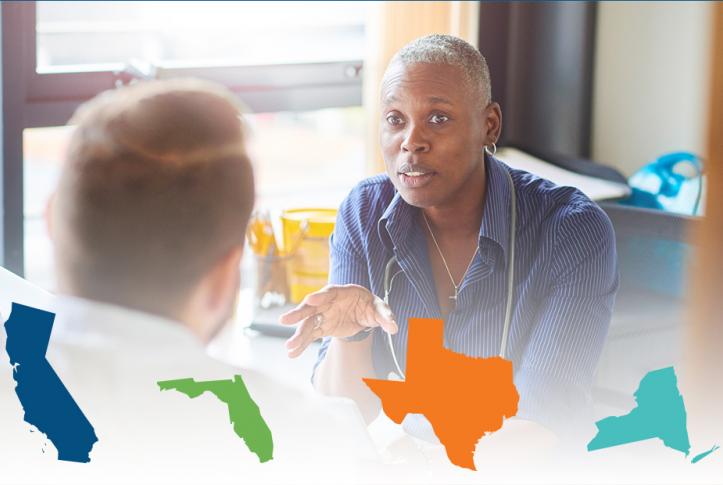Abstract
Issue: The Affordable Care Act has significantly increased health insurance coverage and access to care among U.S. adults nationwide. However, the law gives states flexibility in implementing certain provisions, leading to wide variations between states in consumers’ experiences.
Goal: To examine the differences in insurance coverage, access to care, and medical bill problems in the four largest states—California, Florida, New York, and Texas—all of which have made different choices in implementing the law.
Methods: Analysis of the Commonwealth Fund Biennial Health Insurance Survey, 2016.
Findings and Conclusions: In 2016, uninsured rates among adults ages 19 to 64 across the four states varied from 7 percent in New York and 10 percent in California to 16 percent in Florida and 25 percent in Texas. This variation was also apparent in the proportions of residents reporting problems getting needed care because of the cost—significantly lower in California and New York than in Florida and Texas. Lower percentages of Californians and New Yorkers reported having a medical bill problem in the past 12 months or having accrued medical debt compared to Floridians and Texans. These variations might be explained by several factors: whether the state expanded Medicaid eligibility; whether it ran its own health insurance marketplace; what the uninsured rate was prior to the Affordable Care Act; differences in the cost protections provided by private health plans; and demographic differences.
Background
More than 30 million Americans now have health insurance under the provisions of the Affordable Care Act.1 These provisions include those that have allowed or encouraged people to enroll in coverage through expanded Medicaid eligibility, tax credits to help pay for premiums, state and federal outreach efforts, and consumer-friendly market regulations.2 A recent analysis found that the percentage of uninsured working-age adults dropped from 20 percent in 2010 to 12 percent in 2016.3
The law gives states flexibility in implementing provisions, including the choice of operating their own health insurance marketplace or leaving that task to the federal government. Moreover, in 2012, the U.S. Supreme Court gave states the option to decide whether or not to expand Medicaid eligibility to more lower-income adults. These choices, combined with each state’s unique demographics and history, have resulted in varying experiences among Americans. In this brief, we use data from the Commonwealth Fund Biennial Health Insurance Survey to examine differences in health insurance coverage, problems getting needed care because of costs, and medical bill and debt problems among 19-to-64-year-old adults in the nation’s four largest states: California, Florida, New York, and Texas.4
These states fall into two distinct categories. The first group, California and New York, both operate their own health insurance marketplaces and have expanded eligibility for Medicaid to adults with incomes at or below 138 percent of the federal poverty level—$16,394 for an individual or $33,534 for a family of four. Florida and Texas, the second group, are using the federal marketplace to enroll residents in health plans and have declined to expand Medicaid eligibility (Exhibit 1).
Survey Findings
Texas Has Highest Uninsured Rate of the Four Largest States
The uninsured rate has fallen in all four states since 2012, prior to the implementation of the ACA’s major coverage expansions (Exhibit 2).5,6 Analyses of federal surveys have found similar declines in the uninsured rate during this period.7,8
Among the four states, the proportion of working-age adults without health coverage in 2016 was highest in Florida and Texas, at 16 percent and 25 percent, respectively (Exhibit 2).9 In California, the uninsured rate was 10 percent; in New York, it was 7 percent.
Young adults have experienced the largest gains in coverage nationally (Exhibit 3). According to the survey, by 2016 the national uninsured rate for 19-to-34-year-olds was 15 percent, compared to 27 percent in 2010 (the year adult children became eligible to remain on a parent’s health plan until age 26).10 But the rate varied by state. In California, 8 percent of young adults were uninsured, compared with 10 percent in New York, 23 percent in Florida, and 30 percent in Texas.
There are also significant differences in coverage rates for adults with low incomes. Adults with incomes below 100 percent of the federal poverty level—that is, $11,880 for an individual or $24,300 for a family of four—are faring best in California and New York (Exhibit 4). Nine percent of low-income Californians and 15 percent of low-income New Yorkers are uninsured, compared with 22 percent of low-income adults in Florida and 39 percent in Texas.11
Adults in small firms are more likely to be uninsured in Florida and Texas than those in California and New York. Fourteen percent of adults in small firms are uninsured in California, 12 percent in New York, 24 percent in Florida, and 37 percent in Texas. These differences are likely partly explained by states’ decisions on expanding Medicaid.
Demographics also likely contribute to differences in coverage rates. Undocumented immigrants are ineligible for subsidized coverage or Medicaid under the law. According to the Pew Research Center, undocumented immigrants make up 6.1 percent of the Texas population, one of the highest proportions in the country.12
Californians and New Yorkers Have Lower Rates of Problems Getting Needed Health Care Because of Cost
Expanded insurance coverage is helping people get the care they need. In 2012, an estimated 43 percent of working-age adults, or about 80 million people, did not get needed care because of cost. By 2016, this had dropped to 34 percent, or 63 million people.13 There is significant variation among the four states. Twenty-eight percent of Californians and 29 percent of New Yorkers reported at least one cost-related access problem, compared with 41 percent of Floridians and 45 percent of Texans (Exhibit 5).14 These differences remain statistically significant even after taking into account the variations in states’ demographic profiles, including age, gender, income, health status, race and ethnicity, education level, and immigration status (Appendix Table 1).
There is a range of factors associated with state variation in responses to the cost-related survey questions (Exhibit 5). First, insurance coverage itself plays a large role. Across the U.S., insured adults have historically reported cost-related access problems at much lower rates than uninsured adults.15 In California and New York, the higher rates of insurance coverage likely play a role in the two states’ lower rates of cost-related access problems. Fewer people in California and New York have to pay for the full costs of their care when they get sick.
But the quality of health insurance coverage—particularly, how much people have to pay out of pocket relative to their income when they get sick—also makes a difference. For example, the survey found that a significantly smaller share of insured New Yorkers and Californians (8% and 13%, respectively) had large deductibles—5 percent or more of income—compared with Texans (17%) and Floridians (19%) (data not shown).16 Even among people with employer plans, which tend to be more cost-protective, more people in Florida and Texas had higher deductibles than did those in California and New York. Recent federal data showed that in 2015, 67 percent of employees with single-person insurance plans in California, and 74 percent in New York, had a deductible compared to 91 percent in Florida and 93 percent in Texas.17
People in California and New York Have Lower Rates of Medical Bill and Debt Problems
Nationally, there has been a modest but significant reduction in the percentage of adults who report medically related financial difficulties. In 2012, 41 percent of working-age adults, or an estimated 75 million people, said they had problems paying their medical bills in the past 12 months or were paying off medical debt. In 2016, this had dropped to 37 percent, an estimated 70 million people.18
Fewer adults in California and New York said they had problems paying their medical bills or were paying off medical debt than did adults in Florida and Texas (Exhibit 6). Twenty-eight percent of Californians and New Yorkers said that in the past 12 months they had a problem or were unable to pay their medical bills, had been contacted by a collection agency for unpaid medical bills, had to change their way of life to pay medical bills, or were paying off medical bills over time. In contrast, 41 percent of adults in Florida and 44 percent in Texas reported at least one of these problems.19 These differences remained even after taking into account the states’ demographic profiles, including age, gender, income, health status, race and ethnicity, education level, and immigration status.
Conclusion
The Affordable Care Act has significantly affected health insurance coverage and access among U.S. adults. But the decisions made by state leaders in implementing federal policy, along with other state laws, have ongoing implications for their residents. California and New York began seeing declines in their adult uninsured rate earlier than other states because of such choices. California expanded eligibility for Medicaid even before 2014 by creating the Low Income Health Program, which provided coverage to adults with incomes less than 200 percent of poverty.20 New York expanded Medicaid eligibility to parents with incomes up to 150 percent of poverty and childless adults up to 100 percent of poverty starting in 2000.21 In addition, both states opted to establish their own marketplaces and have conducted expansive outreach campaigns to increase awareness of coverage options. Alternatively, Florida and Texas—although they have experienced robust enrollment in private plans through the federal health insurance marketplace—have not expanded Medicaid eligibility and have made less progress covering uninsured residents.
However, the variation in insured rates is not entirely the result of states’ decision. The ACA does not provide access to any new coverage options for undocumented immigrants. They are ineligible for Medicaid coverage and cannot purchase private plans through the marketplace, subsidized or unsubsidized. This is likely a contributing factor in Texas’s higher uninsured rate.
While expanded coverage is the necessary first step to improving timely access to care and reducing medical financial burdens among U.S. families, the quality and comprehensiveness of coverage across all sources of insurance—marketplace plans, individual market plans, employer-provided coverage, and Medicaid—also has a significant impact.
The gains documented in this survey and many other private and federal analyses indicate that the Affordable Care Act has been successful in insuring millions of Americans and enabling them to get health care they may not have been able to afford previously. Further expanding coverage and improving affordability should remain a priority. Alternatively, repealing the law without a replacement that is at least equally effective will risk reversing the substantial gains the nation has made.



